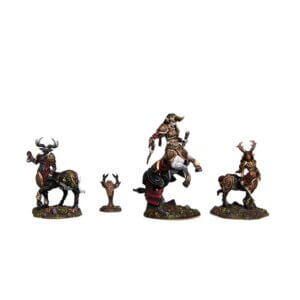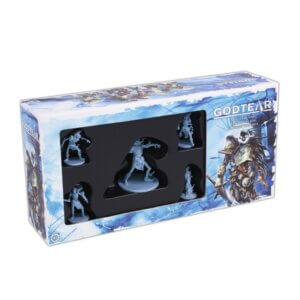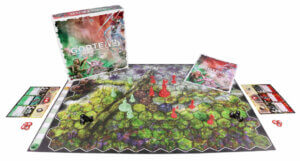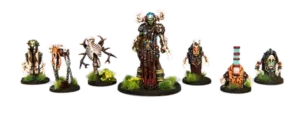The Battle Begins
The Champion, a rotting skeleton, steps carefully through the brush, eyes sweeping for his goal. Behind him creak his marrow minions, support for the dangerous mission. Rattlebone sights on the shimmering tear of a god, points a fleshless finger, and his band advances. On his left, arrows fly past, lancing ahead into enemies as yet unseen; Lorsann is doing her part to buy Rattlebone his time and cost their foes their lives.
Up close, the tear glistens, its shape immaculate and glimmering with a god’s power. Rattlebone is the first here, and he plants his banner, ready to soak up the tear’s might. If Lorsann can only give them—
A massive, horned monster bashes through the trees opposite the tear. Roaring in frightful rage, ignoring Lorsann’s arrow volley, Rangosh charges Rattlebone with violent fury. A bash, a breaking, and Rattlebone’s banner is all but thrown asunder. As the skeletal shaper calls for aid, Rangosh raises a fist, only to find a shield rising to meet it.
Rhodri, always a step slow, always dependable, pushes Rangosh back. Rattlebone, on his feet, secures his banner, the tear, the moment. Yet, in the distance, Lorsann’s horn sounds. This clash might be concluded, but the war for the tears has just begun.
A Simple Skirmish
Godtear, by Steamforged Games, began its battling in 2019, launching a fantasy skirmish brawler built for two-player tussles right as COVID struck. That ill luck might have had you missing the memo on this particular title, something worth correcting so you and Domination Dan can start tossing dice and capturing objectives with a vibrant cast, simple-yet-strategic rules, and a playtime perfect for any afternoon or evening.
A full Godtear game brings together six champions, three on either side, and their minion cadre. Whip out the board, pick a scenario with its attendant tears (the literal tears of gods in this case), and you’re about ready to start clashing. While those with larger collections and more experience can start off with a draft to pick teams, it’s easy enough to grab and go if you’re introducing newer players, a concession more games, particularly ones dependent on a strong player community, could learn from.
 Godtear’s ease of access comes from more than just small team sizes: every champion is color-coded, a touch that is more than just dodging ubiquitous grey plastic. Take a red Slayer champion and you’ll know, at a glance, that the hero scores their points by eliminating the enemy team. They’ll likely be brawlers, or at least capable of throwing down with the enemy. A blue Guardian, meanwhile, anchors your forces, holding tears against enemy onslaughts. Yellow Maelstroms wipe minions off the board, while green Shapers focus on taking objectives. Your champions and minions all come with svelte stat cards explaining all their abilities, meaning you won’t be digging through a novel’s worth of keywords either.
Godtear’s ease of access comes from more than just small team sizes: every champion is color-coded, a touch that is more than just dodging ubiquitous grey plastic. Take a red Slayer champion and you’ll know, at a glance, that the hero scores their points by eliminating the enemy team. They’ll likely be brawlers, or at least capable of throwing down with the enemy. A blue Guardian, meanwhile, anchors your forces, holding tears against enemy onslaughts. Yellow Maelstroms wipe minions off the board, while green Shapers focus on taking objectives. Your champions and minions all come with svelte stat cards explaining all their abilities, meaning you won’t be digging through a novel’s worth of keywords either.
I defy you to find many other skirmish games that’ll give a player an instant guide on how to play their team.
That’s not to say Godtear doesn’t have depth to spare, just that it comes as much from the gameplay as it does complicated list-building. You might not want to take a random squad to a tournament, but for a quick weekend game or lunch break battle, Godtear offers a swift way to get started.
Yet setup’s only that – we’re here for the game, so what’s Godtear like once it gets going?
Two Track Tumble
Many skirmish games drop the units on the battlefield and, like some Mad Max race, kick off a madcap melee, with dice and damage flowing back and forth in delicious chaos. Godtear instead asks you to slow down, take a breath, and plan just how you’ll be taking those sweet, sweet tears.
The overall victor in any Godtear game gets their goodies by points scored at the end of each round. Those points, changing in value as the game goes on (a five round game swings from 1 to 3 points, then back down to 1 again in the final round), encourages planning ahead while allowing comeback victories. You might, for instance, give a fast-moving foe the field early on while your forces get in position for a mid-game hammer blow. In other games, ceding the early ground is often the same as ceding the entire battle.
Not here, and not just in the total score either.
 See, Godtear paces its rounds in two phases. The first, the plot phase, puts your people on the move. Every champion card is double-sided, with differing abilities in each phase. Plotting, which is just as it sounds, has your team moving every figure, activating abilities and securing objectives all in one go. There’s little fighting, just positioning, and while moving first lets you sculpt the battlefield, going second lets you prepare to scour it, launching into ambushes or sitting back and setting traps.
See, Godtear paces its rounds in two phases. The first, the plot phase, puts your people on the move. Every champion card is double-sided, with differing abilities in each phase. Plotting, which is just as it sounds, has your team moving every figure, activating abilities and securing objectives all in one go. There’s little fighting, just positioning, and while moving first lets you sculpt the battlefield, going second lets you prepare to scour it, launching into ambushes or sitting back and setting traps.
Once the plot phase concludes, the clash phase begins, and it’s here the classic skirmish game dice come out to play. Flip over your champion cards and get to deciding who goes and who stays, as you’ll be rolling to hit, then to wound in back-and-forth activations till the round goes dark. As your champions score their color-based points, you’ll move your marker on the round’s ladder towards your side in a neat tug-of-war. At the round’s end, the marker’s side is the victor and earns the round’s points.
Then everyone gets up and goes at it again.
These battles aren’t just maniacal mosh pits either, as Godtear leverages scenarios to mix up the mauling. One game might have you chasing those tears as they disappear from a once-crowded map, while another could spawn new tears as the game goes on, forcing your champions to make unexpected moves. In general, the world you start with won’t be the same as the one you finish in.
If your armies were a hundred heroes large, the two-track turns might promise a weekend-munching playtime, but Godtear keeps things quick, letting experienced players knock out a game in an hour. Newbies won’t take much longer, as the small skirmish size keeps the learning burden light. In other words, if you’re hunting a skirmish game with a competitive scene that’s also a viable weeknight warrior, Godtear deserves a look.
Champion Collector
As any grizzled skirmish veteran knows, though, embarking on a new miniatures game is often a big commitment. You’ve got hordes of plastic to purchase, miniatures to assemble, paint, and organize. Building a viable team can mean tons of add-ons, researching the best buddies for your core champions, and before you know it, you’re babbling about advanced stats and arcane lore to your pals who are just trying to roll some dice on a Tuesday night.
Godtear hears your plight, my friend, and while it’s not a budget title, it does make getting from box to table about as easy as a miniatures game can.
First and foremost, Godtear offers its miniatures fully assembled and painted in the champion’s scoring color scheme. You can open the box, plop the figures onto your table, and know, to a rough degree, how they’re going to help your team. Artists can prime and paint over the plastic just as they would with any mini, but even brush wizards can appreciate being able to get in games without the gray.
 Second, Godtear lets you get a taste of its system with a pair of solid starter sets. Each one scores you a couple champions, assorted minions, and the accessories needed to play. With those alone you can rattle off some smaller-scale 1v1 battles, giving you an introduction while guiding you to what other champions might pique your interest. Or, if you’re a fan of both starter set champions, adding on a third gives you a full force to take on the world.
Second, Godtear lets you get a taste of its system with a pair of solid starter sets. Each one scores you a couple champions, assorted minions, and the accessories needed to play. With those alone you can rattle off some smaller-scale 1v1 battles, giving you an introduction while guiding you to what other champions might pique your interest. Or, if you’re a fan of both starter set champions, adding on a third gives you a full force to take on the world.
Godtear doesn’t force faction lines either, letting you pick and choose your paragons from all across a broad spectrum. Really want Mournblade and his soulless sword teaming up with Lily, Nature’s own avatar? Go for it. There’s no arbitrary rule keeping you from playing with whom and what you want. This also makes it easy to invest in a few champions, pooling them to make a draft a viable proposition, or rolling up a different squad to take to your next game night.
A Hero’s Call
Once you’ve assembled your champions, Godtear offers up a few ways to get the battle going. First, the one we’ve touched on a couple times, is a draft. You and your partner, complete with trash talking, take turns choosing champions one after another. For new folks, the color coding makes for an easy at-a-glance composition guide, like grabbing a couple red Slayers to pair with a yellow Maelstrom to just go all in on absolute destruction.
It’s what any honest player would do.
 Once you have your feet wet, drafting grows with you, letting you counter your opponent’s choices or swap strategies with your third pick, adding a neat metagame to your Godtear nights. The small warband size means drafts won’t take long, but you’ll still get those delectable decisions.
Once you have your feet wet, drafting grows with you, letting you counter your opponent’s choices or swap strategies with your third pick, adding a neat metagame to your Godtear nights. The small warband size means drafts won’t take long, but you’ll still get those delectable decisions.
Competitive play eschews the drafting and gets you right into the brawling, with you and your opponents bringing handpicked teams. It’s the way most games are played, and where you’ll have the chance to hone your strategy for high stakes rumbles. Steamforged Games have committed to supporting Godtear with regular new champions, yes, but also organized play, with frameworks for tournaments and campaigns. The latter guide you through a series of linked scenarios, with champions leveling up and learning new skills as the game goes on.
Game store nights are regular Godtear fixtures too, letting you make new friends and smash anyone too cowardly not to go with an all-Slayer squad. Noble Knight hosts Godtear meetups every other Friday at its store too, marking a satisfying start to a weekend.
All in all, Godtear makes for an easy entry into the skirmish format, letting you get a taste for tactical combat without complicated rule sets or mini assembly. Its price is in line with similar games, and the swift play puts it on par with the fastest, making Godtear a good time for anyone wanting to explore another fantastic side of our hobby.
Written by Adam Knight
Spinning stories and playing games under the direction of his two cats, Adam delights in the roll of the dice and a well-told tale. Find more of his adventures at Black Key Books.


